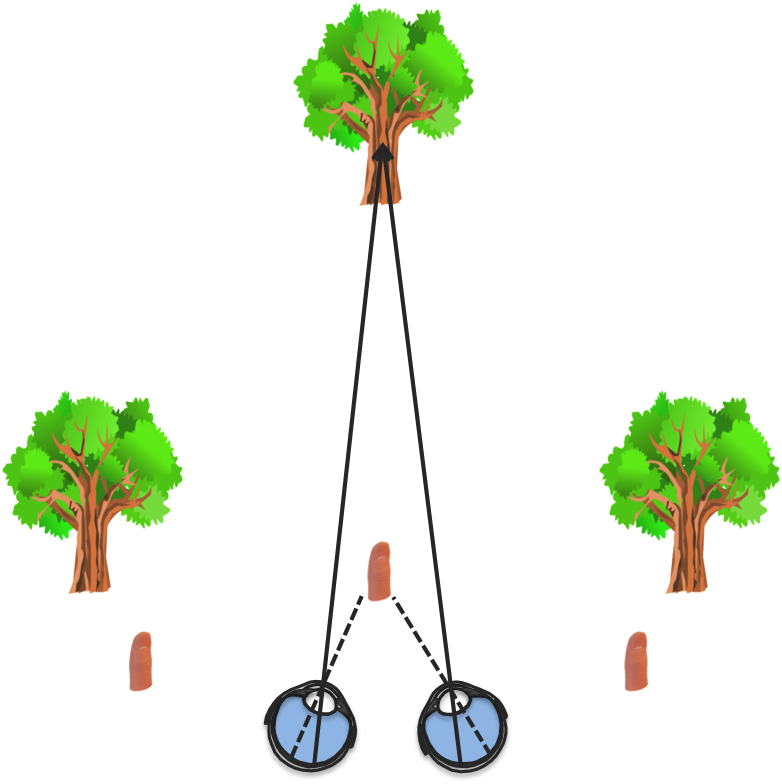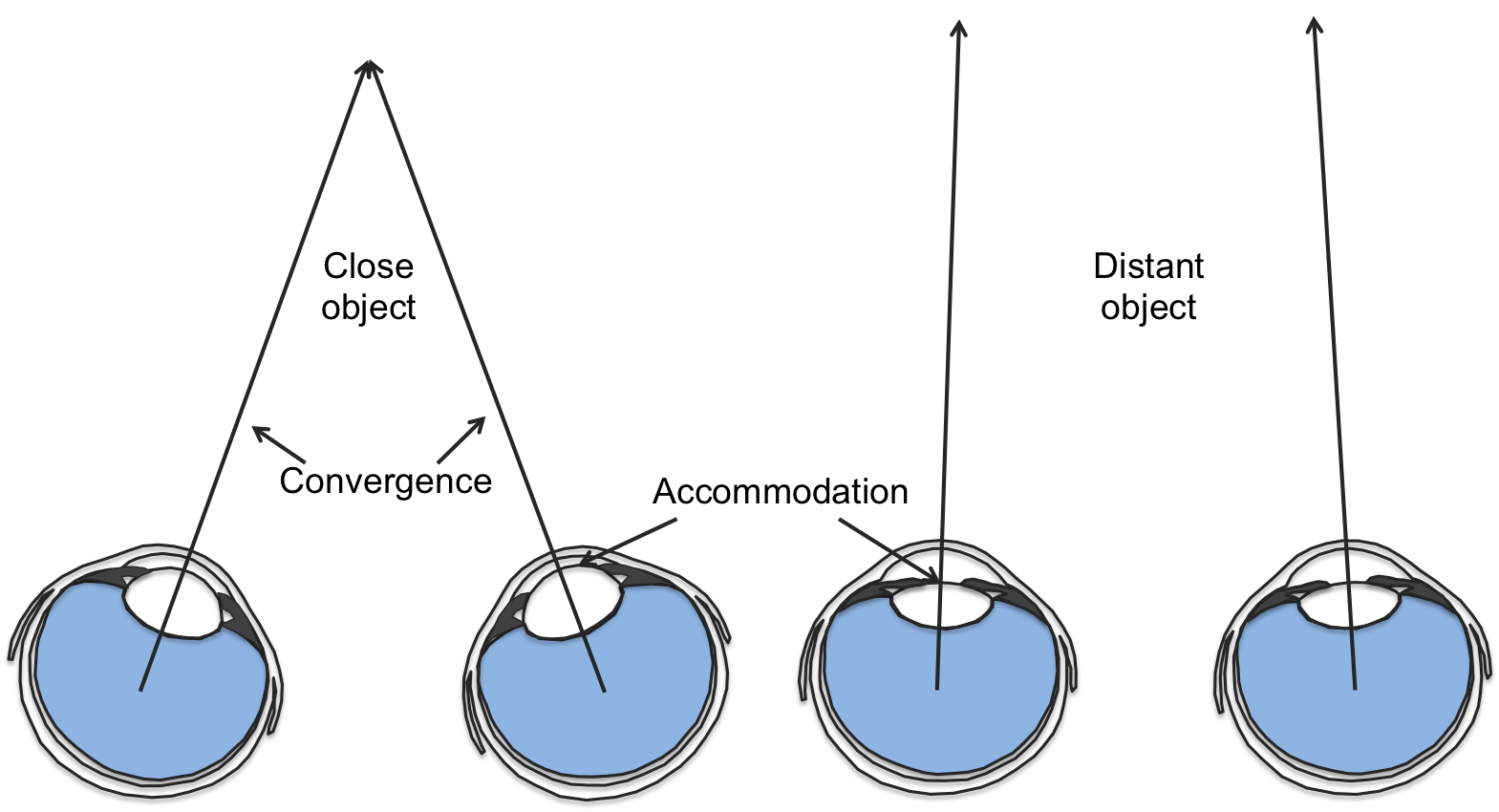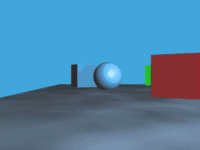Depth perception is our ability to perceive the world in three dimensions (3D), and to gauge how far away an object is. This actually occurs at the visual cortex of our brain with information coming from our eyes. Such information includes those that involve both eyes (binocular cues) and those that involve only one eye (monocular cues) .
Binocular cues- seeing 3D with two eyes. There are two main binocular cues that help us to perceive depth:
Stereopsis, or retinal (binocular) disparity, or binocular parallax: Because our eyes (and that of many animals) are located at different lateral positions on the head, binocular vision results in two slightly different images of the same scene projected onto the retinas of the eyes. The differences are mainly in the relative positions of objects in the two images(as shown in the right figure). Such positional differences are referred to as binocular disparities. The visual cortex of our brain processes the disparities to yield depth perception. Animals with greater eye separation, such as hammerhead sharks, can have a much greater depth perception. This can be very useful when trying to catch fast-moving prey.
Convergence: When the two eyes focus on the same object, they will agle inwards towards each other  (convergence). Depending on the distance of the object, the eyes will converge more (for colse-up object) or less (for distant object). The extra effort used by the muscles on the outside of each eyeball gives a clue to the brain about how far away the object is. Try holding your finger 10 cm in front of your eyes and focusing on it, you will feel the eye muscles at work much sooner than if your finger is 50 cm away.
(convergence). Depending on the distance of the object, the eyes will converge more (for colse-up object) or less (for distant object). The extra effort used by the muscles on the outside of each eyeball gives a clue to the brain about how far away the object is. Try holding your finger 10 cm in front of your eyes and focusing on it, you will feel the eye muscles at work much sooner than if your finger is 50 cm away.
3D movies make use of binocular disparity by providing each eye with a different image to create the 3D effect. However, the brain does not receive any cues from convergence as it normally would. This is why some people may feel uncomfortable when watching 3D movies.
These binocular cues are most effective for objects up to 6 m away. Beyond that, our eye separation does not give a great enough difference in images to be useful in depth perception.
Monocular cues – 3D information from a single eye. With one eye closed, we can still perceive the world in 3D and move around without crashing into things. This is because of monocular cues that help us to gauge the distance of an object. Some of these monocular cues are as follows:
Accommodation: The ciliary muscles inside the eye adjust the shape of the lens so that we can focus on an object. Depending on the distance of that object, the ciliary muscles contracts more (for close-up object) or less (for distant object) to focus. The effort required provides the brain with information about distance of the object. Accommodation occurs in both eyes, but it is still a monocular cue, because one eye alone would give the same information as would both.
Linear perspective is the monocular cue provided by the convergence of lines toward a single point on the horizon. Looking down a set of railroad tracks is a good example. We know that the tracks do not converge; they are parallel throughout, but when we look down the tracks, it appears that they converge to a single point. This is also clearly illustrated by the roads in the above picture, giving us the perception of a 3D world.
Renaissance artists discovered that they could reproduce this phenomenon on a two-dimensional canvas. Artists have been using that representation since, and “primitive art” is often described as art that does not use perspective.
Relative size: Over the years, we have learned the normal sizes of various objects. So when we see an object whose size shouldn’t change becoming larger or smaller, we interpret that as a distance cue (closer or farther). So, when we look down the road, we see the cars becoming smaller and know that they are moving farther away.
Superposition/Interposition: Objects that are in front of other objects may partially block our view of the rearmost object. Because we know what the object should look like, yet we see only part of it, we interpret the obstructed object as being farther away.
Shadows: The way that light falls onto an object and reflects off its surfaces, and the shadows created also provide effective cues for our brain to determine the shape of objects and their position in space.
Motion parallax: If you move your head, objects that are close to you will  appear to move faster and more than those objects that are further away. This is clearly noted when we sit in a moving car and watch things passing by outside.
appear to move faster and more than those objects that are further away. This is clearly noted when we sit in a moving car and watch things passing by outside.
By Nathaniel Domek, CC BY 3.0, https://commons.wikimedia.org/w/index.phpcurid=5061516
Sharp focus or blurry: If two objects are at the same distance, they will both appear to be in focus. Objects that are closer or further away will appear blurry.
Definition and textures: Close objects will have a lot of detail and definition apparent. More distant objects will not show with as much detail. This is very noticeable when looking at a field of grass. Close up, the blades of grass will be noticeable. Further away, the grass is more of a sea of green. Texture of an object is also affected by our proximity to it. The closer one is to something, the more detail or texture one can see. For example, if I look at a wall from 20 feet away, it will look fairly smooth. But, as we move closer, we begin to notice the roughness and texture. Such correlation between distance and texture also provides depth information to our brain.
Vividness of colours: distant objects often appear less bright and colourful. This is due to the scattering of light as it travels from that distant object. Having more of the atmosphere to travel through means that light will be scattered more, so the colours will not seem as bright.
Note that the last three cues are not so obvious in the pictures taken by a camera, this is because modern cameras have complex lens that give much larger depth of view than our simple eyes (objects at different distances can be in focus simultaneously). With our eyes, if we focus on a close-up object, other objects at different distances become blurry and less defined.
How to create 3D movies?
Essentially, 3D movies try to mimic the stereoscopic capabilities of human eyes. The cameras used for shooting 3-D films have 2 lenses placed adjacent to each other, closely resembling a pair of human eyes. Alternatively, movies shot using regular 2-D cameras can be converted to 3-D in post-production using special 2-D to 3-D conversion software. Visual effects would have to be created using computer-generated imagery (CGI) to accomplish the same effect (animated 3-D films are produced in a similar fashion).
This setup enables two sets of images of the same scene to be captured, each with a slightly different perspective. In the cinema, both sets of images are projected simultaneously onto the same screen (which is why the image looks blurry without the special glasses). Now, all that needs to be done is for each of our eyes to see the particular image and our brain to merge them into one 3D picture. This is where the special 3D glasses come in.

